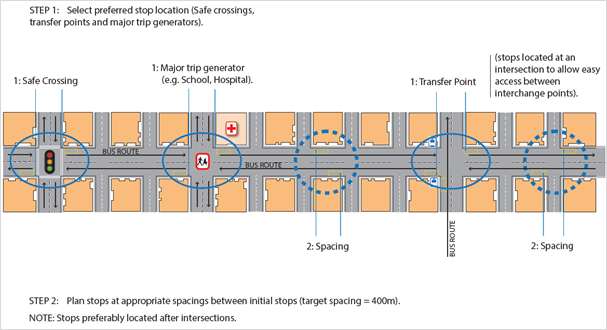Bus stops should be spaced to balance accessibility and efficiency of the bus service and to provide ‘paired’ bus stops for services running in opposite directions.
The optimal distance from one bus stop to the next depends on a wide variety of factors that have to be balanced but is usually 250–800m (see table below).
A more frequent stopping pattern is appropriate around major trip generators (usually in town or city centres) and important community facilities (for example, places of employment, places of education and hospitals). Locate bus stops as close as possible to these major trip generators and important community facilities. Good practice bus stop location and spacing is illustrated in the figure below.

Good practice principles for bus stop spacing and location. (Source: Auckland Transport Engineering Design Code Public Transport Bus Infrastructure) View larger image [PNG, 85 KB]
Auckland Transport Engineering Design Code Public Transport Bus Infrastructure (external link)
For buses to offer people an attractive and viable alternative to private cars, bus stop spacing design must consider and balance the street’s place and movement functions and passenger demand for the stop. Bus journey times are affected by the number of stops on a route – the more stops, the more choice, but the longer journey duration. Bus stop spacing is also a factor in accessibility – how far people are expected to walk between stops.
To achieve optimal spacing, carefully balance passengers’ need to get to and from bus stops easily with their need for an efficient service (that is, one that doesn’t stop too often). The table below provides guidance on bus stop spacing in different locations.
Table: Bus stop spacing guidance
| Location of bus stop |
Recommended spacing between stops |
Comment |
|
Urban area |
400m |
Most people in the bus service catchment area have about a 5-minute walk to or from the nearest bus stop. |
|
Very densely populated area |
250–400m |
Higher density residential areas have higher demand for bus stops. Spacing may be less than 400m but should be no less than 250m. |
|
Rapid transit route |
800m |
Spacing is usually about 800m, because in areas with higher quality bus services people are more likely to be willing to walk a bit further for a better level of service. |
|
Lower density area |
800m or more |
In lower density areas such as rural areas, spacing can be increased up to 800m or more due to low passenger volumes and long distances between properties. |
You do not have to comply with the recommendations in the table above, but should determine bus stop spacing based on:
For example:
For more information on bus stop spacing, see:
Bus stops should be provided in pairs, that is, with inbound and outbound stops are near each other. Where possible, pairs should be staggered in a ‘tail to tail’ arrangement on opposite sides of the road, as shown in the figure below (and, ideally some crossing facility provided between the stops).
Pairing in a tail-to-tail arrangement compared with a pair of bus stops directly opposite each other has safety and operational benefits. It minimises the potential conflict between overtaking vehicles at the bus stops.
The separation distance between paired stops for a stopped bus to be safely overtaken depends on:

Tail-to-tail bus stop arrangement View larger image [JPG, 17 KB]
The figure above is illustrative only and does not show a crossing, but as discussed in the walking access and bus stops near intersections sections of the PTDG, one should be provided, ideally between the stops, to support passengers to cross behind the buses.
The length of the no stopping lines on the approach to bus stops (shown in the figure above) depends on the visibility requirements at the kerb crossings. For example, curvature of a road may impact sightlines.
More guidance on planning crossings for bus stops is provided the following chapters:
For advice about the type of pedestrian crossing appropriate in different contexts, see: